MS4LC41O - Principles of Marketing: Coca-Cola's Market Development
VerifiedAdded on 2023/06/10
|11
|3314
|359
Report
AI Summary
This report provides a comprehensive analysis of Coca-Cola's marketing strategies, focusing on market development, marketing analysis using the BCG matrix, and the marketing mix. It explores Coca-Cola's market penetration and product development strategies, recommending specific approaches for gaining market share and attracting a wider customer base. The report also discusses the importance of a customer-centric strategy and provides insights into Coca-Cola's approach to addressing issues such as high sugar content and water management. The analysis includes evaluations of Coca-Cola's products as cash cows, stars, question marks, and dogs within the BCG matrix, offering a detailed overview of the company's strategic marketing efforts.
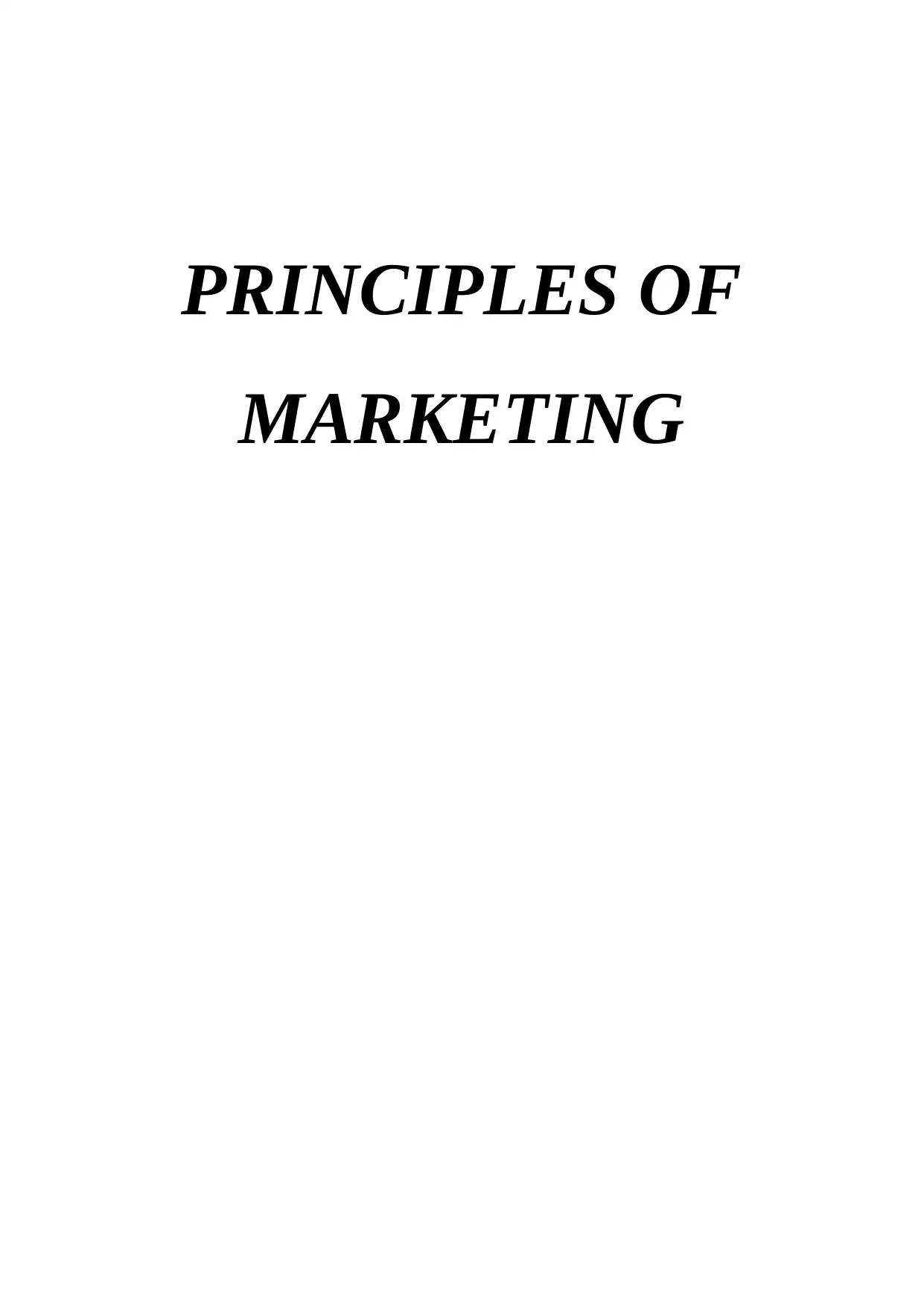
PRINCIPLES OF
MARKETING
MARKETING
Paraphrase This Document
Need a fresh take? Get an instant paraphrase of this document with our AI Paraphraser
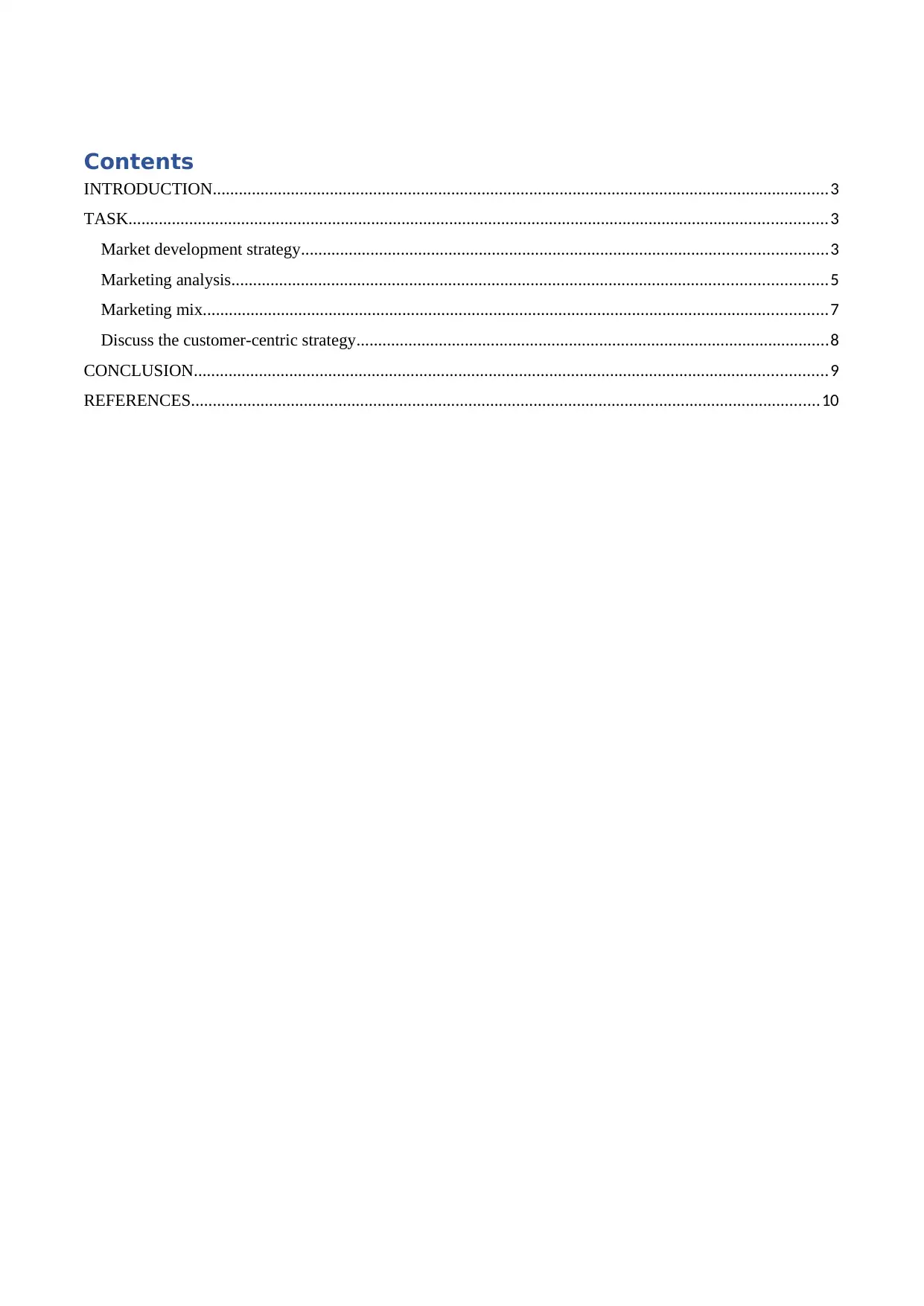
Contents
INTRODUCTION..............................................................................................................................................3
TASK.................................................................................................................................................................3
Market development strategy.........................................................................................................................3
Marketing analysis.........................................................................................................................................5
Marketing mix................................................................................................................................................7
Discuss the customer-centric strategy.............................................................................................................8
CONCLUSION..................................................................................................................................................9
REFERENCES.................................................................................................................................................10
INTRODUCTION..............................................................................................................................................3
TASK.................................................................................................................................................................3
Market development strategy.........................................................................................................................3
Marketing analysis.........................................................................................................................................5
Marketing mix................................................................................................................................................7
Discuss the customer-centric strategy.............................................................................................................8
CONCLUSION..................................................................................................................................................9
REFERENCES.................................................................................................................................................10
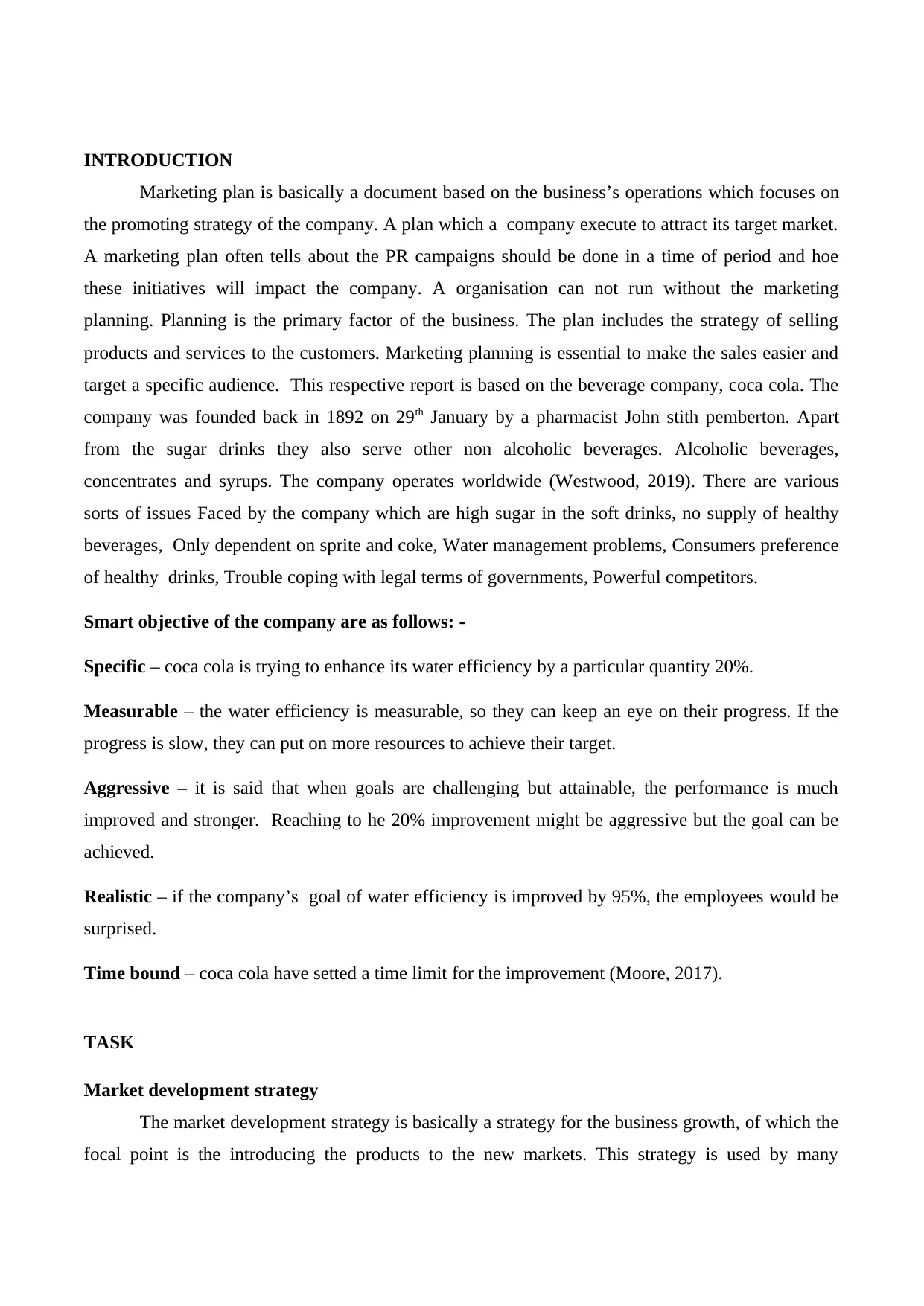
INTRODUCTION
Marketing plan is basically a document based on the business’s operations which focuses on
the promoting strategy of the company. A plan which a company execute to attract its target market.
A marketing plan often tells about the PR campaigns should be done in a time of period and hoe
these initiatives will impact the company. A organisation can not run without the marketing
planning. Planning is the primary factor of the business. The plan includes the strategy of selling
products and services to the customers. Marketing planning is essential to make the sales easier and
target a specific audience. This respective report is based on the beverage company, coca cola. The
company was founded back in 1892 on 29th January by a pharmacist John stith pemberton. Apart
from the sugar drinks they also serve other non alcoholic beverages. Alcoholic beverages,
concentrates and syrups. The company operates worldwide (Westwood, 2019). There are various
sorts of issues Faced by the company which are high sugar in the soft drinks, no supply of healthy
beverages, Only dependent on sprite and coke, Water management problems, Consumers preference
of healthy drinks, Trouble coping with legal terms of governments, Powerful competitors.
Smart objective of the company are as follows: -
Specific – coca cola is trying to enhance its water efficiency by a particular quantity 20%.
Measurable – the water efficiency is measurable, so they can keep an eye on their progress. If the
progress is slow, they can put on more resources to achieve their target.
Aggressive – it is said that when goals are challenging but attainable, the performance is much
improved and stronger. Reaching to he 20% improvement might be aggressive but the goal can be
achieved.
Realistic – if the company’s goal of water efficiency is improved by 95%, the employees would be
surprised.
Time bound – coca cola have setted a time limit for the improvement (Moore, 2017).
TASK
Market development strategy
The market development strategy is basically a strategy for the business growth, of which the
focal point is the introducing the products to the new markets. This strategy is used by many
Marketing plan is basically a document based on the business’s operations which focuses on
the promoting strategy of the company. A plan which a company execute to attract its target market.
A marketing plan often tells about the PR campaigns should be done in a time of period and hoe
these initiatives will impact the company. A organisation can not run without the marketing
planning. Planning is the primary factor of the business. The plan includes the strategy of selling
products and services to the customers. Marketing planning is essential to make the sales easier and
target a specific audience. This respective report is based on the beverage company, coca cola. The
company was founded back in 1892 on 29th January by a pharmacist John stith pemberton. Apart
from the sugar drinks they also serve other non alcoholic beverages. Alcoholic beverages,
concentrates and syrups. The company operates worldwide (Westwood, 2019). There are various
sorts of issues Faced by the company which are high sugar in the soft drinks, no supply of healthy
beverages, Only dependent on sprite and coke, Water management problems, Consumers preference
of healthy drinks, Trouble coping with legal terms of governments, Powerful competitors.
Smart objective of the company are as follows: -
Specific – coca cola is trying to enhance its water efficiency by a particular quantity 20%.
Measurable – the water efficiency is measurable, so they can keep an eye on their progress. If the
progress is slow, they can put on more resources to achieve their target.
Aggressive – it is said that when goals are challenging but attainable, the performance is much
improved and stronger. Reaching to he 20% improvement might be aggressive but the goal can be
achieved.
Realistic – if the company’s goal of water efficiency is improved by 95%, the employees would be
surprised.
Time bound – coca cola have setted a time limit for the improvement (Moore, 2017).
TASK
Market development strategy
The market development strategy is basically a strategy for the business growth, of which the
focal point is the introducing the products to the new markets. This strategy is used by many
⊘ This is a preview!⊘
Do you want full access?
Subscribe today to unlock all pages.

Trusted by 1+ million students worldwide
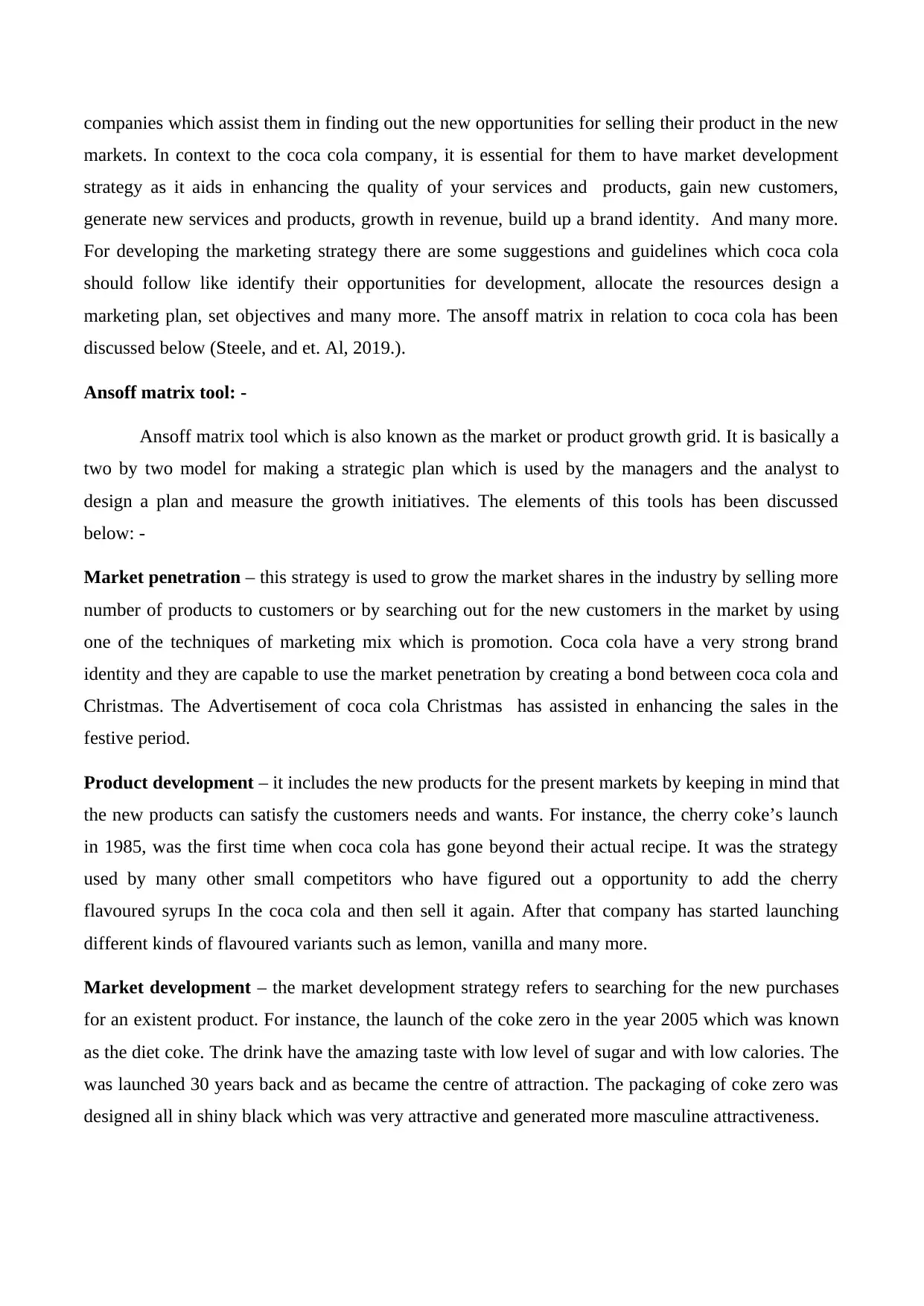
companies which assist them in finding out the new opportunities for selling their product in the new
markets. In context to the coca cola company, it is essential for them to have market development
strategy as it aids in enhancing the quality of your services and products, gain new customers,
generate new services and products, growth in revenue, build up a brand identity. And many more.
For developing the marketing strategy there are some suggestions and guidelines which coca cola
should follow like identify their opportunities for development, allocate the resources design a
marketing plan, set objectives and many more. The ansoff matrix in relation to coca cola has been
discussed below (Steele, and et. Al, 2019.).
Ansoff matrix tool: -
Ansoff matrix tool which is also known as the market or product growth grid. It is basically a
two by two model for making a strategic plan which is used by the managers and the analyst to
design a plan and measure the growth initiatives. The elements of this tools has been discussed
below: -
Market penetration – this strategy is used to grow the market shares in the industry by selling more
number of products to customers or by searching out for the new customers in the market by using
one of the techniques of marketing mix which is promotion. Coca cola have a very strong brand
identity and they are capable to use the market penetration by creating a bond between coca cola and
Christmas. The Advertisement of coca cola Christmas has assisted in enhancing the sales in the
festive period.
Product development – it includes the new products for the present markets by keeping in mind that
the new products can satisfy the customers needs and wants. For instance, the cherry coke’s launch
in 1985, was the first time when coca cola has gone beyond their actual recipe. It was the strategy
used by many other small competitors who have figured out a opportunity to add the cherry
flavoured syrups In the coca cola and then sell it again. After that company has started launching
different kinds of flavoured variants such as lemon, vanilla and many more.
Market development – the market development strategy refers to searching for the new purchases
for an existent product. For instance, the launch of the coke zero in the year 2005 which was known
as the diet coke. The drink have the amazing taste with low level of sugar and with low calories. The
was launched 30 years back and as became the centre of attraction. The packaging of coke zero was
designed all in shiny black which was very attractive and generated more masculine attractiveness.
markets. In context to the coca cola company, it is essential for them to have market development
strategy as it aids in enhancing the quality of your services and products, gain new customers,
generate new services and products, growth in revenue, build up a brand identity. And many more.
For developing the marketing strategy there are some suggestions and guidelines which coca cola
should follow like identify their opportunities for development, allocate the resources design a
marketing plan, set objectives and many more. The ansoff matrix in relation to coca cola has been
discussed below (Steele, and et. Al, 2019.).
Ansoff matrix tool: -
Ansoff matrix tool which is also known as the market or product growth grid. It is basically a
two by two model for making a strategic plan which is used by the managers and the analyst to
design a plan and measure the growth initiatives. The elements of this tools has been discussed
below: -
Market penetration – this strategy is used to grow the market shares in the industry by selling more
number of products to customers or by searching out for the new customers in the market by using
one of the techniques of marketing mix which is promotion. Coca cola have a very strong brand
identity and they are capable to use the market penetration by creating a bond between coca cola and
Christmas. The Advertisement of coca cola Christmas has assisted in enhancing the sales in the
festive period.
Product development – it includes the new products for the present markets by keeping in mind that
the new products can satisfy the customers needs and wants. For instance, the cherry coke’s launch
in 1985, was the first time when coca cola has gone beyond their actual recipe. It was the strategy
used by many other small competitors who have figured out a opportunity to add the cherry
flavoured syrups In the coca cola and then sell it again. After that company has started launching
different kinds of flavoured variants such as lemon, vanilla and many more.
Market development – the market development strategy refers to searching for the new purchases
for an existent product. For instance, the launch of the coke zero in the year 2005 which was known
as the diet coke. The drink have the amazing taste with low level of sugar and with low calories. The
was launched 30 years back and as became the centre of attraction. The packaging of coke zero was
designed all in shiny black which was very attractive and generated more masculine attractiveness.
Paraphrase This Document
Need a fresh take? Get an instant paraphrase of this document with our AI Paraphraser
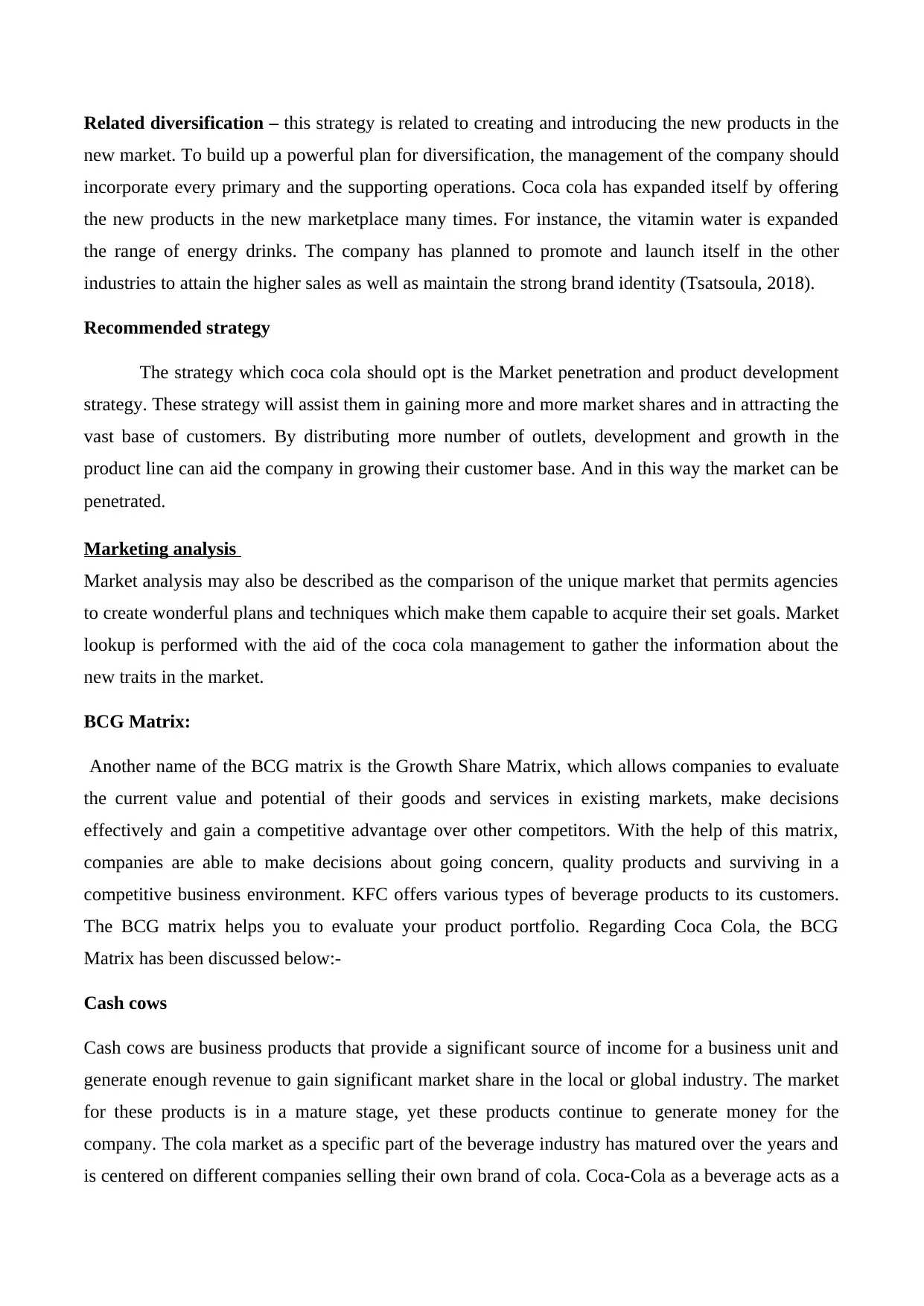
Related diversification – this strategy is related to creating and introducing the new products in the
new market. To build up a powerful plan for diversification, the management of the company should
incorporate every primary and the supporting operations. Coca cola has expanded itself by offering
the new products in the new marketplace many times. For instance, the vitamin water is expanded
the range of energy drinks. The company has planned to promote and launch itself in the other
industries to attain the higher sales as well as maintain the strong brand identity (Tsatsoula, 2018).
Recommended strategy
The strategy which coca cola should opt is the Market penetration and product development
strategy. These strategy will assist them in gaining more and more market shares and in attracting the
vast base of customers. By distributing more number of outlets, development and growth in the
product line can aid the company in growing their customer base. And in this way the market can be
penetrated.
Marketing analysis
Market analysis may also be described as the comparison of the unique market that permits agencies
to create wonderful plans and techniques which make them capable to acquire their set goals. Market
lookup is performed with the aid of the coca cola management to gather the information about the
new traits in the market.
BCG Matrix:
Another name of the BCG matrix is the Growth Share Matrix, which allows companies to evaluate
the current value and potential of their goods and services in existing markets, make decisions
effectively and gain a competitive advantage over other competitors. With the help of this matrix,
companies are able to make decisions about going concern, quality products and surviving in a
competitive business environment. KFC offers various types of beverage products to its customers.
The BCG matrix helps you to evaluate your product portfolio. Regarding Coca Cola, the BCG
Matrix has been discussed below:-
Cash cows
Cash cows are business products that provide a significant source of income for a business unit and
generate enough revenue to gain significant market share in the local or global industry. The market
for these products is in a mature stage, yet these products continue to generate money for the
company. The cola market as a specific part of the beverage industry has matured over the years and
is centered on different companies selling their own brand of cola. Coca-Cola as a beverage acts as a
new market. To build up a powerful plan for diversification, the management of the company should
incorporate every primary and the supporting operations. Coca cola has expanded itself by offering
the new products in the new marketplace many times. For instance, the vitamin water is expanded
the range of energy drinks. The company has planned to promote and launch itself in the other
industries to attain the higher sales as well as maintain the strong brand identity (Tsatsoula, 2018).
Recommended strategy
The strategy which coca cola should opt is the Market penetration and product development
strategy. These strategy will assist them in gaining more and more market shares and in attracting the
vast base of customers. By distributing more number of outlets, development and growth in the
product line can aid the company in growing their customer base. And in this way the market can be
penetrated.
Marketing analysis
Market analysis may also be described as the comparison of the unique market that permits agencies
to create wonderful plans and techniques which make them capable to acquire their set goals. Market
lookup is performed with the aid of the coca cola management to gather the information about the
new traits in the market.
BCG Matrix:
Another name of the BCG matrix is the Growth Share Matrix, which allows companies to evaluate
the current value and potential of their goods and services in existing markets, make decisions
effectively and gain a competitive advantage over other competitors. With the help of this matrix,
companies are able to make decisions about going concern, quality products and surviving in a
competitive business environment. KFC offers various types of beverage products to its customers.
The BCG matrix helps you to evaluate your product portfolio. Regarding Coca Cola, the BCG
Matrix has been discussed below:-
Cash cows
Cash cows are business products that provide a significant source of income for a business unit and
generate enough revenue to gain significant market share in the local or global industry. The market
for these products is in a mature stage, yet these products continue to generate money for the
company. The cola market as a specific part of the beverage industry has matured over the years and
is centered on different companies selling their own brand of cola. Coca-Cola as a beverage acts as a
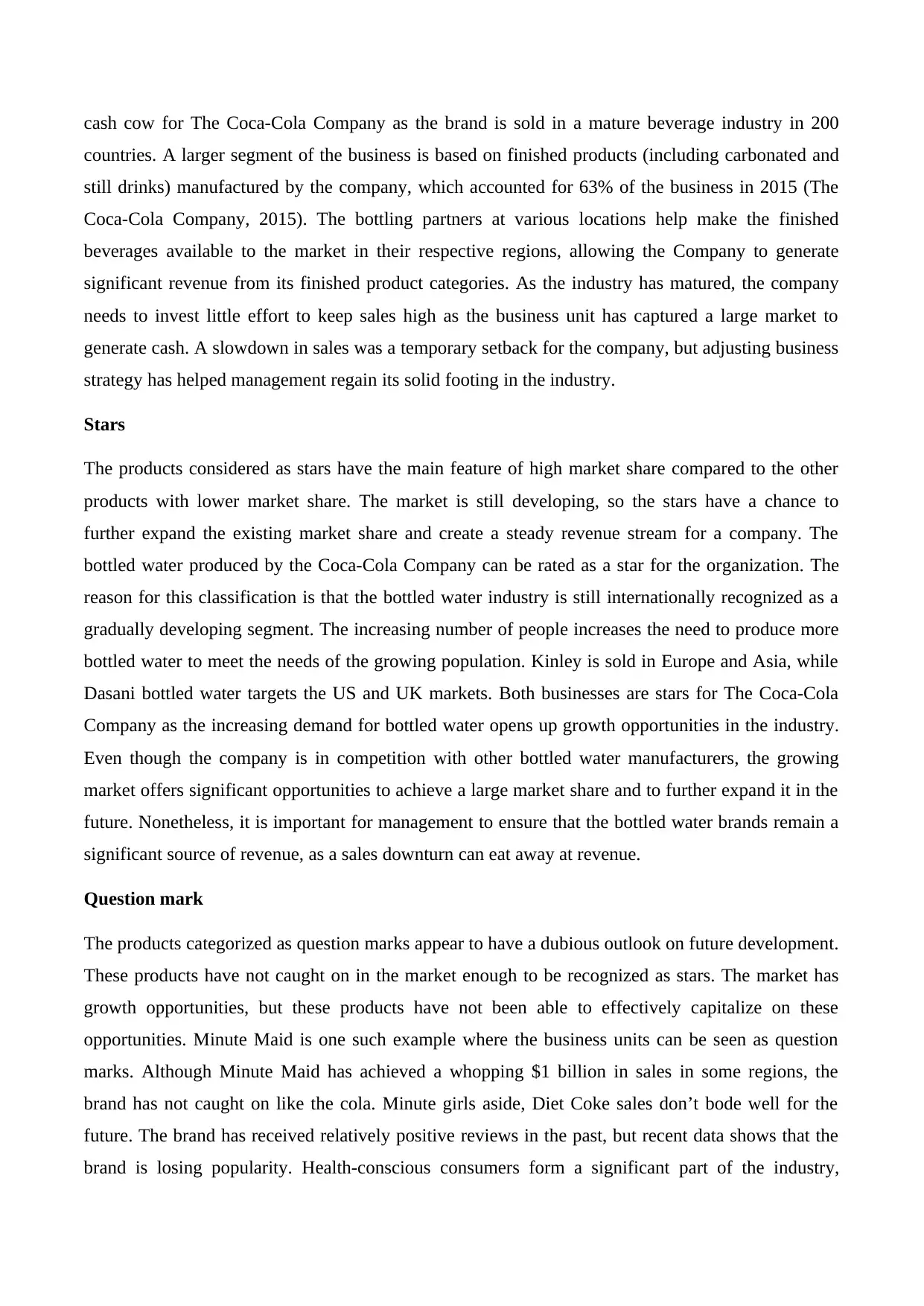
cash cow for The Coca-Cola Company as the brand is sold in a mature beverage industry in 200
countries. A larger segment of the business is based on finished products (including carbonated and
still drinks) manufactured by the company, which accounted for 63% of the business in 2015 (The
Coca-Cola Company, 2015). The bottling partners at various locations help make the finished
beverages available to the market in their respective regions, allowing the Company to generate
significant revenue from its finished product categories. As the industry has matured, the company
needs to invest little effort to keep sales high as the business unit has captured a large market to
generate cash. A slowdown in sales was a temporary setback for the company, but adjusting business
strategy has helped management regain its solid footing in the industry.
Stars
The products considered as stars have the main feature of high market share compared to the other
products with lower market share. The market is still developing, so the stars have a chance to
further expand the existing market share and create a steady revenue stream for a company. The
bottled water produced by the Coca-Cola Company can be rated as a star for the organization. The
reason for this classification is that the bottled water industry is still internationally recognized as a
gradually developing segment. The increasing number of people increases the need to produce more
bottled water to meet the needs of the growing population. Kinley is sold in Europe and Asia, while
Dasani bottled water targets the US and UK markets. Both businesses are stars for The Coca-Cola
Company as the increasing demand for bottled water opens up growth opportunities in the industry.
Even though the company is in competition with other bottled water manufacturers, the growing
market offers significant opportunities to achieve a large market share and to further expand it in the
future. Nonetheless, it is important for management to ensure that the bottled water brands remain a
significant source of revenue, as a sales downturn can eat away at revenue.
Question mark
The products categorized as question marks appear to have a dubious outlook on future development.
These products have not caught on in the market enough to be recognized as stars. The market has
growth opportunities, but these products have not been able to effectively capitalize on these
opportunities. Minute Maid is one such example where the business units can be seen as question
marks. Although Minute Maid has achieved a whopping $1 billion in sales in some regions, the
brand has not caught on like the cola. Minute girls aside, Diet Coke sales don’t bode well for the
future. The brand has received relatively positive reviews in the past, but recent data shows that the
brand is losing popularity. Health-conscious consumers form a significant part of the industry,
countries. A larger segment of the business is based on finished products (including carbonated and
still drinks) manufactured by the company, which accounted for 63% of the business in 2015 (The
Coca-Cola Company, 2015). The bottling partners at various locations help make the finished
beverages available to the market in their respective regions, allowing the Company to generate
significant revenue from its finished product categories. As the industry has matured, the company
needs to invest little effort to keep sales high as the business unit has captured a large market to
generate cash. A slowdown in sales was a temporary setback for the company, but adjusting business
strategy has helped management regain its solid footing in the industry.
Stars
The products considered as stars have the main feature of high market share compared to the other
products with lower market share. The market is still developing, so the stars have a chance to
further expand the existing market share and create a steady revenue stream for a company. The
bottled water produced by the Coca-Cola Company can be rated as a star for the organization. The
reason for this classification is that the bottled water industry is still internationally recognized as a
gradually developing segment. The increasing number of people increases the need to produce more
bottled water to meet the needs of the growing population. Kinley is sold in Europe and Asia, while
Dasani bottled water targets the US and UK markets. Both businesses are stars for The Coca-Cola
Company as the increasing demand for bottled water opens up growth opportunities in the industry.
Even though the company is in competition with other bottled water manufacturers, the growing
market offers significant opportunities to achieve a large market share and to further expand it in the
future. Nonetheless, it is important for management to ensure that the bottled water brands remain a
significant source of revenue, as a sales downturn can eat away at revenue.
Question mark
The products categorized as question marks appear to have a dubious outlook on future development.
These products have not caught on in the market enough to be recognized as stars. The market has
growth opportunities, but these products have not been able to effectively capitalize on these
opportunities. Minute Maid is one such example where the business units can be seen as question
marks. Although Minute Maid has achieved a whopping $1 billion in sales in some regions, the
brand has not caught on like the cola. Minute girls aside, Diet Coke sales don’t bode well for the
future. The brand has received relatively positive reviews in the past, but recent data shows that the
brand is losing popularity. Health-conscious consumers form a significant part of the industry,
⊘ This is a preview!⊘
Do you want full access?
Subscribe today to unlock all pages.

Trusted by 1+ million students worldwide
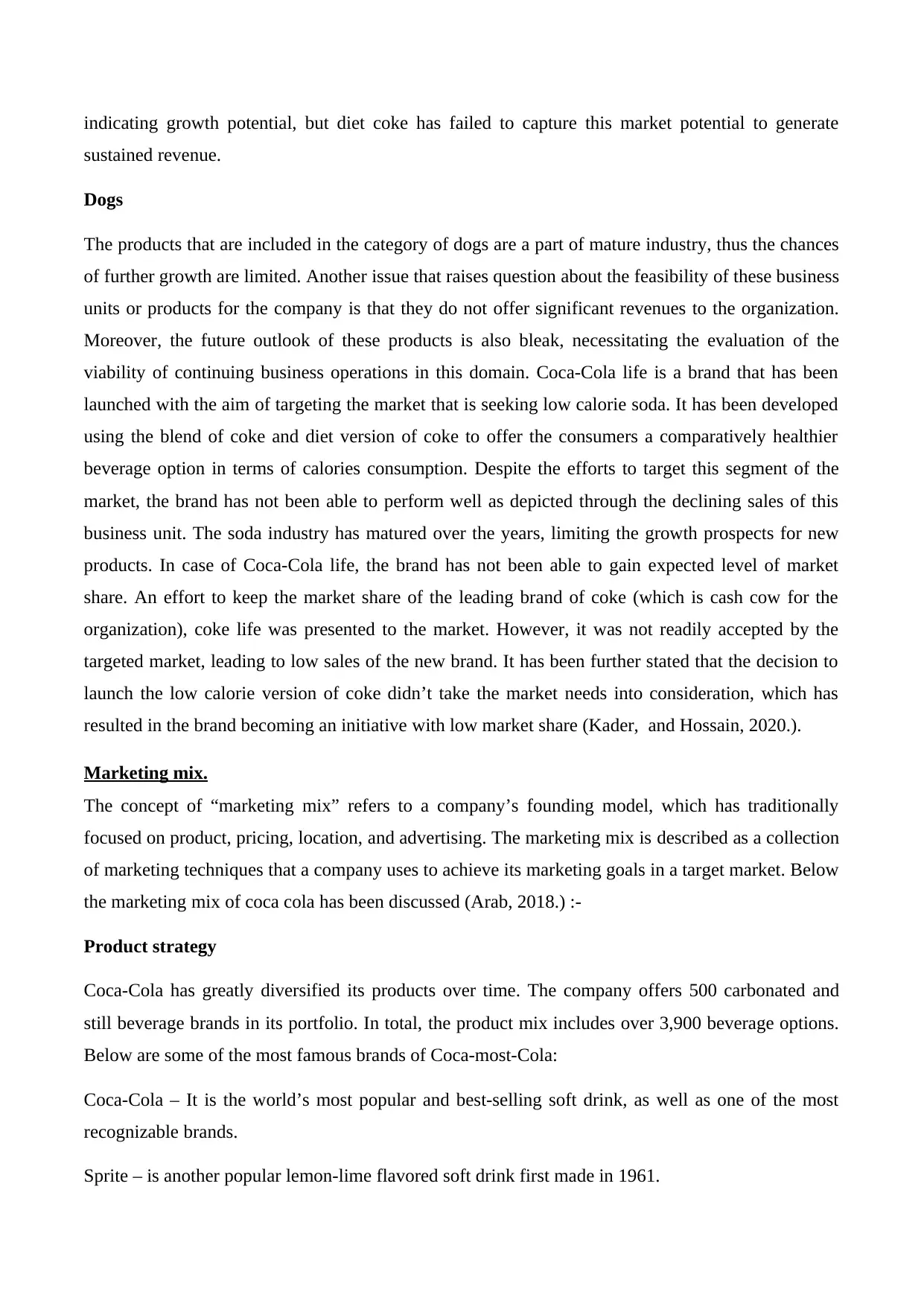
indicating growth potential, but diet coke has failed to capture this market potential to generate
sustained revenue.
Dogs
The products that are included in the category of dogs are a part of mature industry, thus the chances
of further growth are limited. Another issue that raises question about the feasibility of these business
units or products for the company is that they do not offer significant revenues to the organization.
Moreover, the future outlook of these products is also bleak, necessitating the evaluation of the
viability of continuing business operations in this domain. Coca-Cola life is a brand that has been
launched with the aim of targeting the market that is seeking low calorie soda. It has been developed
using the blend of coke and diet version of coke to offer the consumers a comparatively healthier
beverage option in terms of calories consumption. Despite the efforts to target this segment of the
market, the brand has not been able to perform well as depicted through the declining sales of this
business unit. The soda industry has matured over the years, limiting the growth prospects for new
products. In case of Coca-Cola life, the brand has not been able to gain expected level of market
share. An effort to keep the market share of the leading brand of coke (which is cash cow for the
organization), coke life was presented to the market. However, it was not readily accepted by the
targeted market, leading to low sales of the new brand. It has been further stated that the decision to
launch the low calorie version of coke didn’t take the market needs into consideration, which has
resulted in the brand becoming an initiative with low market share (Kader, and Hossain, 2020.).
Marketing mix.
The concept of “marketing mix” refers to a company’s founding model, which has traditionally
focused on product, pricing, location, and advertising. The marketing mix is described as a collection
of marketing techniques that a company uses to achieve its marketing goals in a target market. Below
the marketing mix of coca cola has been discussed (Arab, 2018.) :-
Product strategy
Coca-Cola has greatly diversified its products over time. The company offers 500 carbonated and
still beverage brands in its portfolio. In total, the product mix includes over 3,900 beverage options.
Below are some of the most famous brands of Coca-most-Cola:
Coca-Cola – It is the world’s most popular and best-selling soft drink, as well as one of the most
recognizable brands.
Sprite – is another popular lemon-lime flavored soft drink first made in 1961.
sustained revenue.
Dogs
The products that are included in the category of dogs are a part of mature industry, thus the chances
of further growth are limited. Another issue that raises question about the feasibility of these business
units or products for the company is that they do not offer significant revenues to the organization.
Moreover, the future outlook of these products is also bleak, necessitating the evaluation of the
viability of continuing business operations in this domain. Coca-Cola life is a brand that has been
launched with the aim of targeting the market that is seeking low calorie soda. It has been developed
using the blend of coke and diet version of coke to offer the consumers a comparatively healthier
beverage option in terms of calories consumption. Despite the efforts to target this segment of the
market, the brand has not been able to perform well as depicted through the declining sales of this
business unit. The soda industry has matured over the years, limiting the growth prospects for new
products. In case of Coca-Cola life, the brand has not been able to gain expected level of market
share. An effort to keep the market share of the leading brand of coke (which is cash cow for the
organization), coke life was presented to the market. However, it was not readily accepted by the
targeted market, leading to low sales of the new brand. It has been further stated that the decision to
launch the low calorie version of coke didn’t take the market needs into consideration, which has
resulted in the brand becoming an initiative with low market share (Kader, and Hossain, 2020.).
Marketing mix.
The concept of “marketing mix” refers to a company’s founding model, which has traditionally
focused on product, pricing, location, and advertising. The marketing mix is described as a collection
of marketing techniques that a company uses to achieve its marketing goals in a target market. Below
the marketing mix of coca cola has been discussed (Arab, 2018.) :-
Product strategy
Coca-Cola has greatly diversified its products over time. The company offers 500 carbonated and
still beverage brands in its portfolio. In total, the product mix includes over 3,900 beverage options.
Below are some of the most famous brands of Coca-most-Cola:
Coca-Cola – It is the world’s most popular and best-selling soft drink, as well as one of the most
recognizable brands.
Sprite – is another popular lemon-lime flavored soft drink first made in 1961.
Paraphrase This Document
Need a fresh take? Get an instant paraphrase of this document with our AI Paraphraser
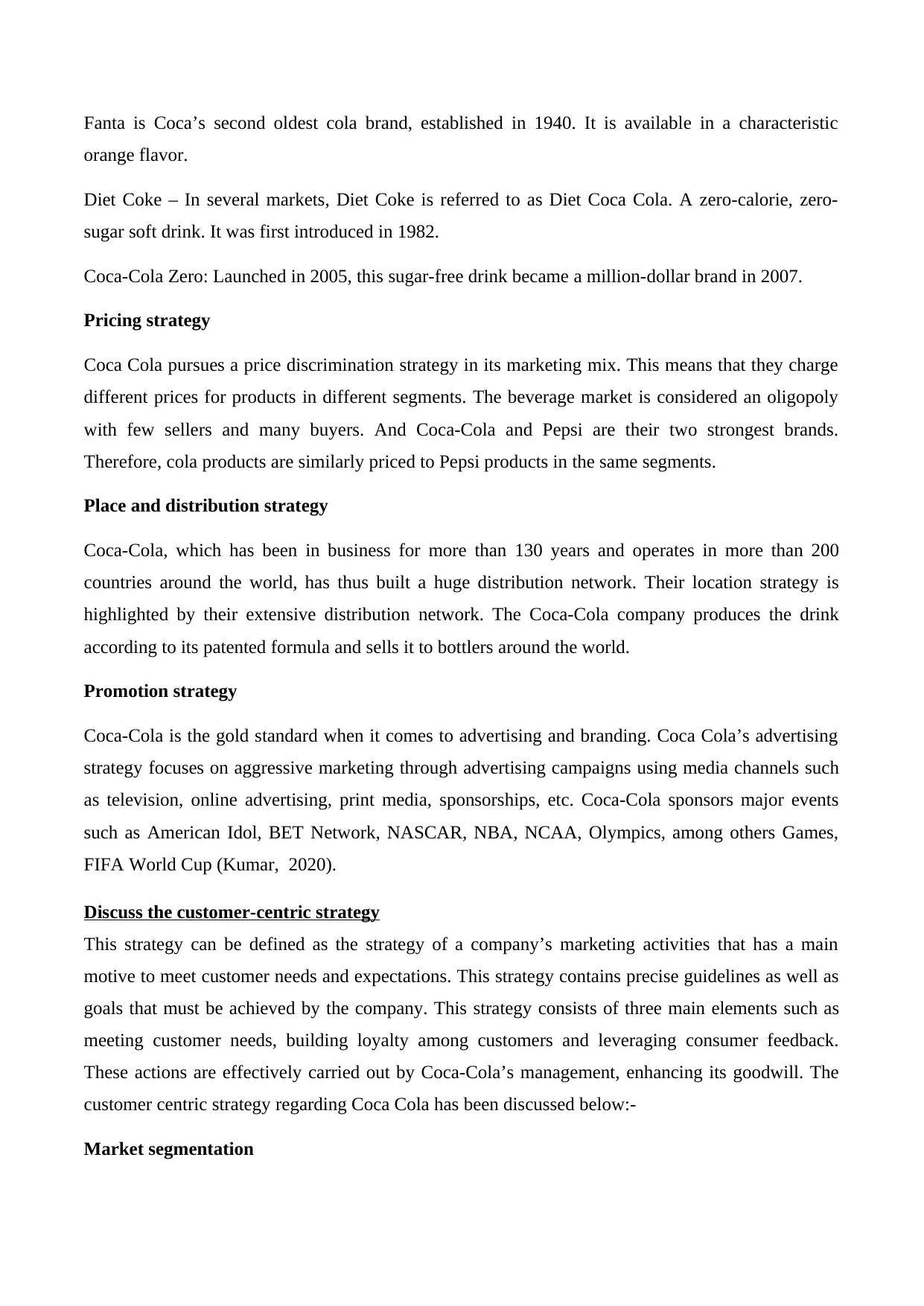
Fanta is Coca’s second oldest cola brand, established in 1940. It is available in a characteristic
orange flavor.
Diet Coke – In several markets, Diet Coke is referred to as Diet Coca Cola. A zero-calorie, zero-
sugar soft drink. It was first introduced in 1982.
Coca-Cola Zero: Launched in 2005, this sugar-free drink became a million-dollar brand in 2007.
Pricing strategy
Coca Cola pursues a price discrimination strategy in its marketing mix. This means that they charge
different prices for products in different segments. The beverage market is considered an oligopoly
with few sellers and many buyers. And Coca-Cola and Pepsi are their two strongest brands.
Therefore, cola products are similarly priced to Pepsi products in the same segments.
Place and distribution strategy
Coca-Cola, which has been in business for more than 130 years and operates in more than 200
countries around the world, has thus built a huge distribution network. Their location strategy is
highlighted by their extensive distribution network. The Coca-Cola company produces the drink
according to its patented formula and sells it to bottlers around the world.
Promotion strategy
Coca-Cola is the gold standard when it comes to advertising and branding. Coca Cola’s advertising
strategy focuses on aggressive marketing through advertising campaigns using media channels such
as television, online advertising, print media, sponsorships, etc. Coca-Cola sponsors major events
such as American Idol, BET Network, NASCAR, NBA, NCAA, Olympics, among others Games,
FIFA World Cup (Kumar, 2020).
Discuss the customer-centric strategy
This strategy can be defined as the strategy of a company’s marketing activities that has a main
motive to meet customer needs and expectations. This strategy contains precise guidelines as well as
goals that must be achieved by the company. This strategy consists of three main elements such as
meeting customer needs, building loyalty among customers and leveraging consumer feedback.
These actions are effectively carried out by Coca-Cola’s management, enhancing its goodwill. The
customer centric strategy regarding Coca Cola has been discussed below:-
Market segmentation
orange flavor.
Diet Coke – In several markets, Diet Coke is referred to as Diet Coca Cola. A zero-calorie, zero-
sugar soft drink. It was first introduced in 1982.
Coca-Cola Zero: Launched in 2005, this sugar-free drink became a million-dollar brand in 2007.
Pricing strategy
Coca Cola pursues a price discrimination strategy in its marketing mix. This means that they charge
different prices for products in different segments. The beverage market is considered an oligopoly
with few sellers and many buyers. And Coca-Cola and Pepsi are their two strongest brands.
Therefore, cola products are similarly priced to Pepsi products in the same segments.
Place and distribution strategy
Coca-Cola, which has been in business for more than 130 years and operates in more than 200
countries around the world, has thus built a huge distribution network. Their location strategy is
highlighted by their extensive distribution network. The Coca-Cola company produces the drink
according to its patented formula and sells it to bottlers around the world.
Promotion strategy
Coca-Cola is the gold standard when it comes to advertising and branding. Coca Cola’s advertising
strategy focuses on aggressive marketing through advertising campaigns using media channels such
as television, online advertising, print media, sponsorships, etc. Coca-Cola sponsors major events
such as American Idol, BET Network, NASCAR, NBA, NCAA, Olympics, among others Games,
FIFA World Cup (Kumar, 2020).
Discuss the customer-centric strategy
This strategy can be defined as the strategy of a company’s marketing activities that has a main
motive to meet customer needs and expectations. This strategy contains precise guidelines as well as
goals that must be achieved by the company. This strategy consists of three main elements such as
meeting customer needs, building loyalty among customers and leveraging consumer feedback.
These actions are effectively carried out by Coca-Cola’s management, enhancing its goodwill. The
customer centric strategy regarding Coca Cola has been discussed below:-
Market segmentation
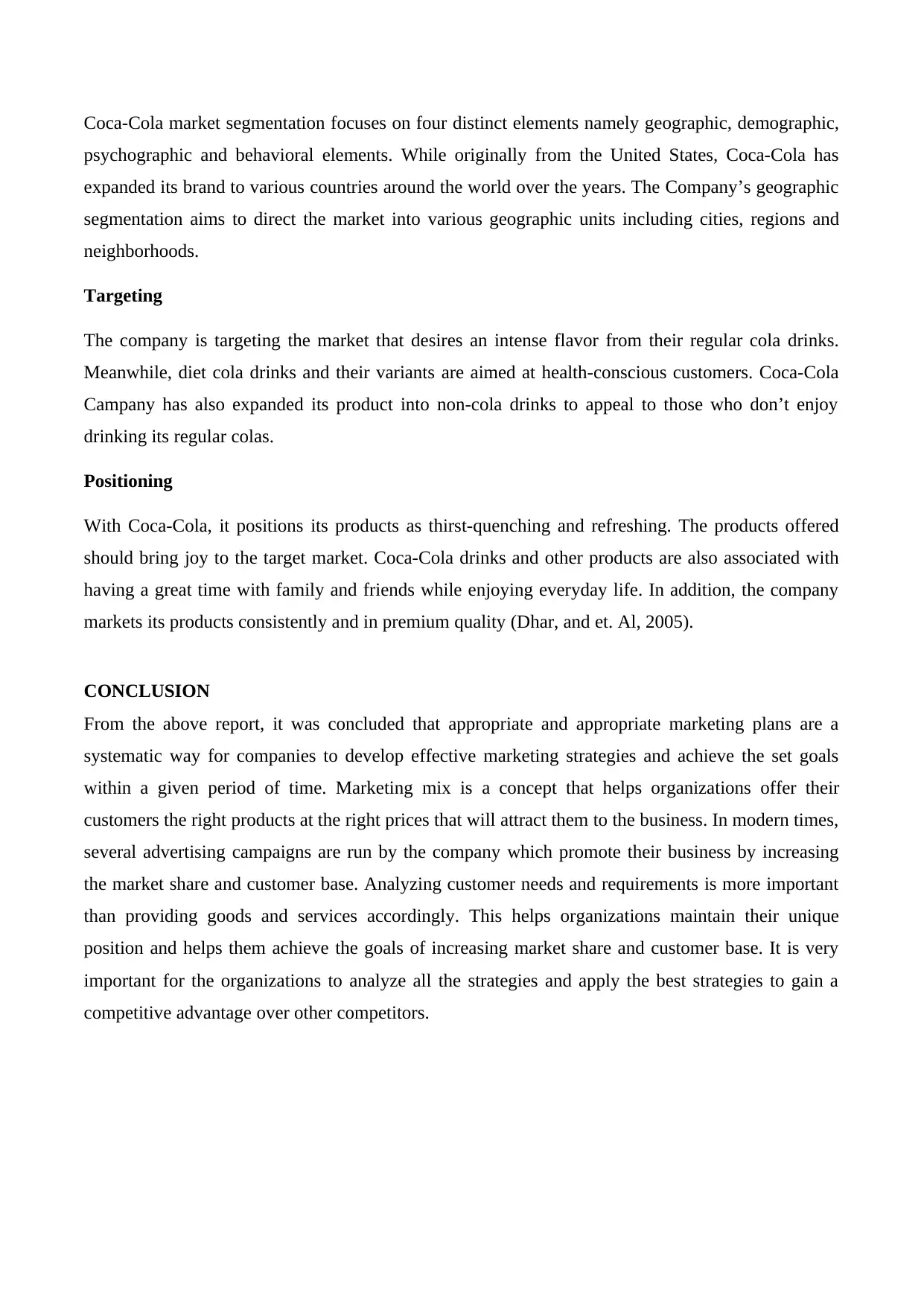
Coca-Cola market segmentation focuses on four distinct elements namely geographic, demographic,
psychographic and behavioral elements. While originally from the United States, Coca-Cola has
expanded its brand to various countries around the world over the years. The Company’s geographic
segmentation aims to direct the market into various geographic units including cities, regions and
neighborhoods.
Targeting
The company is targeting the market that desires an intense flavor from their regular cola drinks.
Meanwhile, diet cola drinks and their variants are aimed at health-conscious customers. Coca-Cola
Campany has also expanded its product into non-cola drinks to appeal to those who don’t enjoy
drinking its regular colas.
Positioning
With Coca-Cola, it positions its products as thirst-quenching and refreshing. The products offered
should bring joy to the target market. Coca-Cola drinks and other products are also associated with
having a great time with family and friends while enjoying everyday life. In addition, the company
markets its products consistently and in premium quality (Dhar, and et. Al, 2005).
CONCLUSION
From the above report, it was concluded that appropriate and appropriate marketing plans are a
systematic way for companies to develop effective marketing strategies and achieve the set goals
within a given period of time. Marketing mix is a concept that helps organizations offer their
customers the right products at the right prices that will attract them to the business. In modern times,
several advertising campaigns are run by the company which promote their business by increasing
the market share and customer base. Analyzing customer needs and requirements is more important
than providing goods and services accordingly. This helps organizations maintain their unique
position and helps them achieve the goals of increasing market share and customer base. It is very
important for the organizations to analyze all the strategies and apply the best strategies to gain a
competitive advantage over other competitors.
psychographic and behavioral elements. While originally from the United States, Coca-Cola has
expanded its brand to various countries around the world over the years. The Company’s geographic
segmentation aims to direct the market into various geographic units including cities, regions and
neighborhoods.
Targeting
The company is targeting the market that desires an intense flavor from their regular cola drinks.
Meanwhile, diet cola drinks and their variants are aimed at health-conscious customers. Coca-Cola
Campany has also expanded its product into non-cola drinks to appeal to those who don’t enjoy
drinking its regular colas.
Positioning
With Coca-Cola, it positions its products as thirst-quenching and refreshing. The products offered
should bring joy to the target market. Coca-Cola drinks and other products are also associated with
having a great time with family and friends while enjoying everyday life. In addition, the company
markets its products consistently and in premium quality (Dhar, and et. Al, 2005).
CONCLUSION
From the above report, it was concluded that appropriate and appropriate marketing plans are a
systematic way for companies to develop effective marketing strategies and achieve the set goals
within a given period of time. Marketing mix is a concept that helps organizations offer their
customers the right products at the right prices that will attract them to the business. In modern times,
several advertising campaigns are run by the company which promote their business by increasing
the market share and customer base. Analyzing customer needs and requirements is more important
than providing goods and services accordingly. This helps organizations maintain their unique
position and helps them achieve the goals of increasing market share and customer base. It is very
important for the organizations to analyze all the strategies and apply the best strategies to gain a
competitive advantage over other competitors.
⊘ This is a preview!⊘
Do you want full access?
Subscribe today to unlock all pages.

Trusted by 1+ million students worldwide
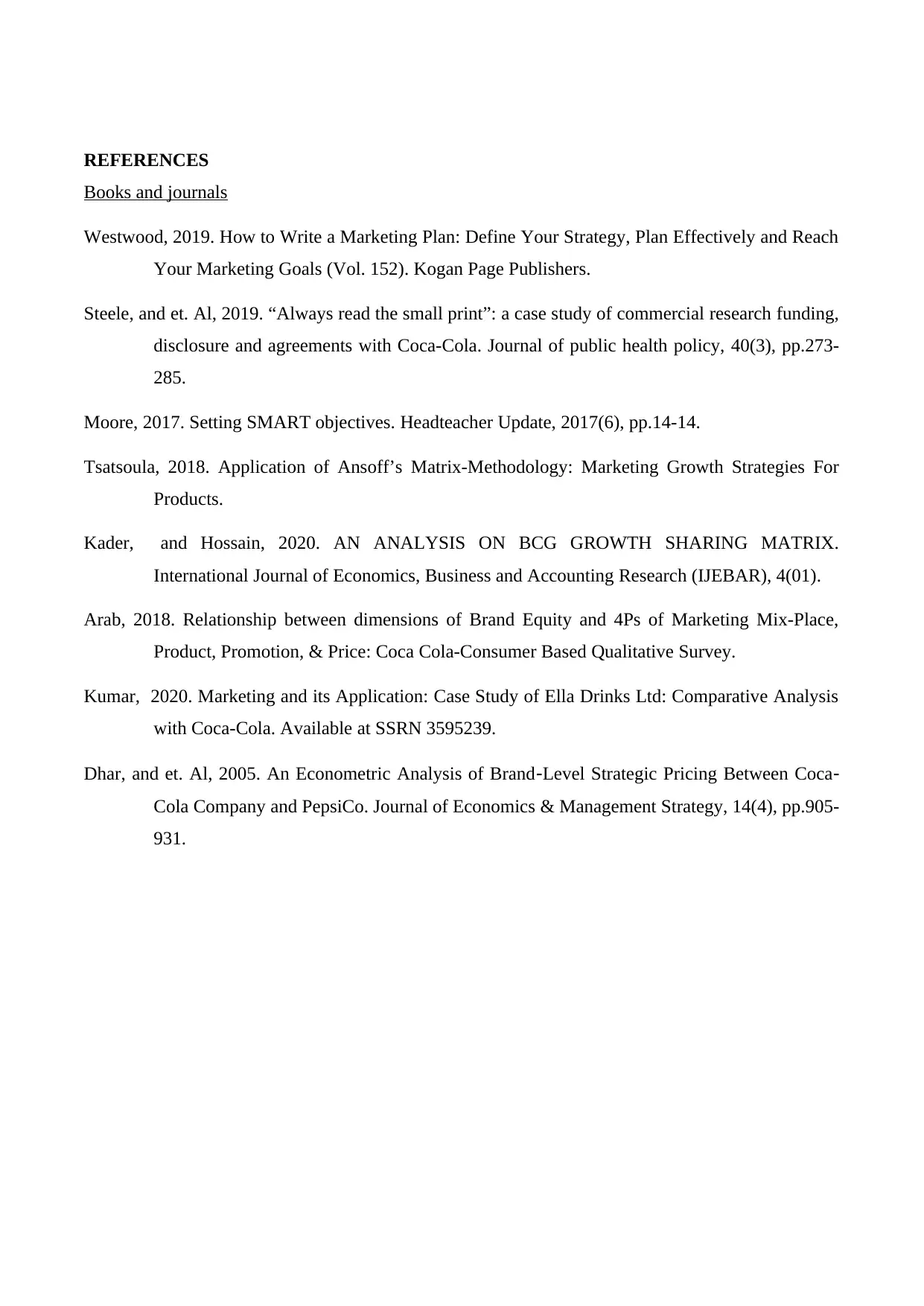
REFERENCES
Books and journals
Westwood, 2019. How to Write a Marketing Plan: Define Your Strategy, Plan Effectively and Reach
Your Marketing Goals (Vol. 152). Kogan Page Publishers.
Steele, and et. Al, 2019. “Always read the small print”: a case study of commercial research funding,
disclosure and agreements with Coca-Cola. Journal of public health policy, 40(3), pp.273-
285.
Moore, 2017. Setting SMART objectives. Headteacher Update, 2017(6), pp.14-14.
Tsatsoula, 2018. Application of Ansoff’s Matrix-Methodology: Marketing Growth Strategies For
Products.
Kader, and Hossain, 2020. AN ANALYSIS ON BCG GROWTH SHARING MATRIX.
International Journal of Economics, Business and Accounting Research (IJEBAR), 4(01).
Arab, 2018. Relationship between dimensions of Brand Equity and 4Ps of Marketing Mix-Place,
Product, Promotion, & Price: Coca Cola-Consumer Based Qualitative Survey.
Kumar, 2020. Marketing and its Application: Case Study of Ella Drinks Ltd: Comparative Analysis
with Coca-Cola. Available at SSRN 3595239.
Dhar, and et. Al, 2005. An Econometric Analysis of Brand‐Level Strategic Pricing Between Coca‐
Cola Company and PepsiCo. Journal of Economics & Management Strategy, 14(4), pp.905-
931.
Books and journals
Westwood, 2019. How to Write a Marketing Plan: Define Your Strategy, Plan Effectively and Reach
Your Marketing Goals (Vol. 152). Kogan Page Publishers.
Steele, and et. Al, 2019. “Always read the small print”: a case study of commercial research funding,
disclosure and agreements with Coca-Cola. Journal of public health policy, 40(3), pp.273-
285.
Moore, 2017. Setting SMART objectives. Headteacher Update, 2017(6), pp.14-14.
Tsatsoula, 2018. Application of Ansoff’s Matrix-Methodology: Marketing Growth Strategies For
Products.
Kader, and Hossain, 2020. AN ANALYSIS ON BCG GROWTH SHARING MATRIX.
International Journal of Economics, Business and Accounting Research (IJEBAR), 4(01).
Arab, 2018. Relationship between dimensions of Brand Equity and 4Ps of Marketing Mix-Place,
Product, Promotion, & Price: Coca Cola-Consumer Based Qualitative Survey.
Kumar, 2020. Marketing and its Application: Case Study of Ella Drinks Ltd: Comparative Analysis
with Coca-Cola. Available at SSRN 3595239.
Dhar, and et. Al, 2005. An Econometric Analysis of Brand‐Level Strategic Pricing Between Coca‐
Cola Company and PepsiCo. Journal of Economics & Management Strategy, 14(4), pp.905-
931.
Paraphrase This Document
Need a fresh take? Get an instant paraphrase of this document with our AI Paraphraser

1 out of 11
Related Documents
Your All-in-One AI-Powered Toolkit for Academic Success.
+13062052269
info@desklib.com
Available 24*7 on WhatsApp / Email
![[object Object]](/_next/static/media/star-bottom.7253800d.svg)
Unlock your academic potential
Copyright © 2020–2025 A2Z Services. All Rights Reserved. Developed and managed by ZUCOL.



